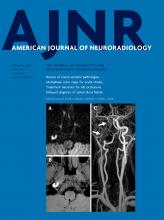Index by author
Guerin, J.
- Head and Neck ImagingOpen AccessThe Forgotten Second Window: A Pictorial Review of Round Window PathologiesJ.C. Benson, F. Diehn, T. Passe, J. Guerin, V.M. Silvera, M.L. Carlson and J. LaneAmerican Journal of Neuroradiology February 2020, 41 (2) 192-199; DOI: https://doi.org/10.3174/ajnr.A6356
Gupta, R.K.
- EDITOR'S CHOICEAdult BrainYou have accessSpiral T1 Spin-Echo for Routine Postcontrast Brain MRI Exams: A Multicenter Multireader Clinical EvaluationM.B. Ooi, Z. Li, R.K. Robison, D. Wang, A.G. Anderson, N.R. Zwart, A. Bakhru, S. Nagaraj, T. Mathews, S. Hey, J.J. Koonen, I.E. Dimitrov, H.T. Friel, Q. Lu, M. Obara, I. Saha, H. Wang, Y. Wang, Y. Zhao, M. Temkit, H.H. Hu, T.L. Chenevert, O. Togao, J.A. Tkach, U.D. Nagaraj, M.C. Pinho, R.K. Gupta, J.E. Small, M.M. Kunst, J.P. Karis, J.B. Andre, J.H. Miller, N.K. Pinter and J.G. PipeAmerican Journal of Neuroradiology February 2020, 41 (2) 238-245; DOI: https://doi.org/10.3174/ajnr.A6409
The authors report a multicenter multireader study that was designed to compare spiral with standard-of-care Cartesian postcontrast structural brain MR imaging on the basis of relative performance in 10 metrics of image quality, artifact prevalence, and diagnostic benefit. Seven clinical sites acquired 88 total subjects. For each subject, sites acquired 2 postcontrast MR imaging scans: a spiral 2D T1 spin-echo, and 1 of 4 routine Cartesian 2D T1 spin-echo/TSE scans. Nine neuroradiologists independently reviewed each subject, with the matching pair of spiral and Cartesian scans compared side-by-side, and scored the subject on 10 image-quality metrics. Spiral was superior to Cartesian in 7 of 10 metrics (flow artifact mitigation, SNR, GM/WM contrast, image sharpness, lesion conspicuity, preference for diagnosing abnormal enhancement, and overall intracranial image quality), comparable in 1 of 10 metrics (motion artifacts), and inferior in 2 of 10 metrics (susceptibility artifacts, overall extracranial image quality). Spiral 2D T1 spin-echo for routine structural brain MR imaging is feasible in the clinic with conventional scanners and was preferred by neuroradiologists for overall postcontrast intracranial evaluation.
Halbach, V.V.
- NeurointerventionOpen AccessImpact of Aortic Arch Anatomy on Technical Performance and Clinical Outcomes in Patients with Acute Ischemic StrokeJ.A. Knox, M.D. Alexander, D.B. McCoy, D.C. Murph, P.J. Hinckley, J.C. Ch'ang, C.F. Dowd, V.V. Halbach, R.T. Higashida, M.R. Amans, S.W. Hetts and D.L. CookeAmerican Journal of Neuroradiology February 2020, 41 (2) 268-273; DOI: https://doi.org/10.3174/ajnr.A6422
Han, C.
- Adult BrainOpen AccessMR Diffusional Kurtosis Imaging–Based Assessment of Brain Microstructural Changes in Patients with Moyamoya Disease before and after RevascularizationP.-G. Qiao, X. Cheng, G.-J. Li, P. Song, C. Han and Z.-H. YangAmerican Journal of Neuroradiology February 2020, 41 (2) 246-254; DOI: https://doi.org/10.3174/ajnr.A6392
Hans, F.-J.
- EDITOR'S CHOICESpine Imaging and Spine Image-Guided InterventionsYou have accessLong-Term Outcome of Patients with Spinal Dural Arteriovenous Fistula: The Dilemma of Delayed DiagnosisF. Jablawi, G.A. Schubert, M. Dafotakis, J. Pons-Kühnemann, F.-J. Hans and M. MullAmerican Journal of Neuroradiology February 2020, 41 (2) 357-363; DOI: https://doi.org/10.3174/ajnr.A6372
Spinal dural arteriovenous fistulas (sdAVFs) usually become symptomatic in elderly men, who are affected 5 times more often than women. Symptoms caused by sdAVF comprise gait disturbances with or without paresis, sensory disturbances in the lower extremities, pain, and sphincter and erectile dysfunction. The authors retrospectively analyzed their medical data base for all patients treated for spinal dural arteriovenous fistula at their institution between 2006 and 2016. Patient age, neurologic status at the time of diagnosis, the duration of symptoms from onset to diagnosis, and follow-up information were evaluated. The extent of medullary T2WI hyperintensity, intramedullary contrast enhancement, and elongation of perimedullary veins on MR imaging at the time of diagnosis were additionally analyzed. Data for long-term outcome analysis were available in 40 patients with a mean follow-up of 52 months. The mean age at the time of diagnosis was 69 years (median, 71 years; range, 53-84 years) with a male predominance (80%). The mean duration of symptoms was 20 months. Spinal dural arteriovenous fistulas are characterized by inter-individually variable clinical presentations, which make a determination of specific predictors for long-term outcome more difficult. Fast and sufficient diagnosis might result in a better outcome after treatment. The diagnosis of spinal dural arteriovenous fistula remains markedly delayed, reflecting an ongoing lack of knowledge and awareness among treating physicians of this rare-but-serious disease.
Hauben, Manfred
- PerspectivesYou have accessPerspectivesManfred HaubenAmerican Journal of Neuroradiology February 2020, 41 (2) 191; DOI: https://doi.org/10.3174/ajnr.P0087
Heck, D.V.
- Clinical ReportYou have accessIntra-Arterial Verapamil Treatment in Oral Therapy–Refractory Reversible Cerebral Vasoconstriction SyndromeJ.M. Ospel, C.H. Wright, R. Jung, L.L.M. Vidal, S. Manjila, G. Singh, D.V. Heck, A. Ray and K.A. BlackhamAmerican Journal of Neuroradiology February 2020, 41 (2) 293-299; DOI: https://doi.org/10.3174/ajnr.A6378
Helguera, M.
- Adult BrainOpen AccessA Method to Estimate Brain Volume from Head CT Images and Application to Detect Brain Atrophy in Alzheimer DiseaseV. Adduru, S.A. Baum, C. Zhang, M. Helguera, R. Zand, M. Lichtenstein, C.J. Griessenauer and A.M. MichaelAmerican Journal of Neuroradiology February 2020, 41 (2) 224-230; DOI: https://doi.org/10.3174/ajnr.A6402
Hess, C.P.
- Adult BrainYou have accessPredictive Value of Noncontrast Head CT with Negative Findings in the Emergency Department SettingA.L. Callen, D.S. Chow, Y.A. Chen, H.R. Richelle, J. Pao, M. Bardis, B.D. Weinberg, C.P. Hess and L.P. SugrueAmerican Journal of Neuroradiology February 2020, 41 (2) 213-218; DOI: https://doi.org/10.3174/ajnr.A6408
Hetts, S.W.
- NeurointerventionOpen AccessImpact of Aortic Arch Anatomy on Technical Performance and Clinical Outcomes in Patients with Acute Ischemic StrokeJ.A. Knox, M.D. Alexander, D.B. McCoy, D.C. Murph, P.J. Hinckley, J.C. Ch'ang, C.F. Dowd, V.V. Halbach, R.T. Higashida, M.R. Amans, S.W. Hetts and D.L. CookeAmerican Journal of Neuroradiology February 2020, 41 (2) 268-273; DOI: https://doi.org/10.3174/ajnr.A6422








